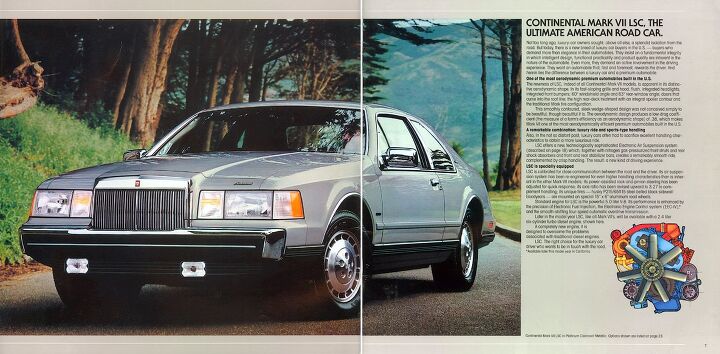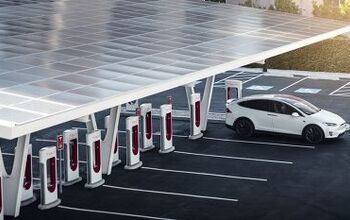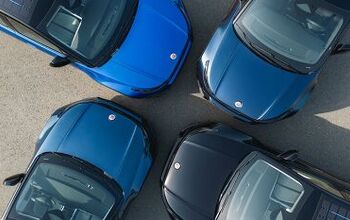Rare Rides Icons: The Lincoln Mark Series Cars, Feeling Continental (Part XXXVIII)

After a review of the Lincoln Continental Mark VII’s completely revamped and modernized styling in our last entry, we’ll spend this today on its interior. As Lincoln attempted to draw a new, more youthful well-heeled customer base to the Mark, the PLC traditionalist of yore faded away. And said youthful customer - usually with an eye on European cars - was less interested in acres of faux wood panel, ruched velour, traditional instruments, and overstuffed button-tufted interiors.
As might be expected, the decrease in all exterior dimensions in the transition from Mark VI to VII was accompanied by a decrease in interior room as well. Most notable was the width: The interior folks at Lincoln had much less to work with on the Mark VII than its predecessors. There was only a slight decrease in the Mark’s width when it moved onto the Panther platform for 1980, as its 78.1 inches was close enough to the 79.7” of the Mark V. But the Fox was no full-size platform, and the modern new Mark VII spanned only 70.9 inches.
Note: Information below pertains largely to trims other than the sporty LSC, which was devoid of wood decor.
A driver who entered the new Mark VII in 1984 found only remnant details of Marks gone by. Faced with a more modern two-spoke steering wheel, the four-spoke Panther design was binned. The wheel was sleeker and had a better implementation of wood trim on its lower half, a notable difference from the Mark VI’s wood-clad center wheel pad, and thin wood strip on the wheel rim. Worth noting, the Mark VI was the only Mark to use a four-spoke wheel.
The Mark VII’s dash was still a vertical affair but was less of a cliff face than the Mark VI's. With a sharply defined center console, there was a notable separation between driver and passenger in Mark VII. Lincoln’s interior design aimed for the “driver’s car” look with its new iteration, and followed the same driver and passenger separation theme that worked for the Thunderbird for many decades.
There was a distinct absence of wood trim in front of the passenger, a first for any Mark generation. A tradition that remained was the small Mark VII badge, inlaid in gold into the dash. Other decorations for passenger viewing enjoyment included two rectangular vents.
Digital gauges retained their basic three-binnacle design from before, with a fuel level indicator, speedometer, and odometer from left to right. Analog gauges were fitted on the sporty LSC model, but not until later in the run in 1986. The gauge binnacles themselves were smaller than before, more recessed, and looked a bit less formal.
Flanking the digital pods were vents, and a central warning light system that was smaller than on the Mark VI, and looked better integrated. New to Mark’s dash design was a second row of buttons and switches that contained things like lighting functions, the antenna control, and the electronic trip computer. Though such a computer was present in Mark VI, it had more functions in the VII and looked more at home.
We take an aside to a flight of Mark VII fancy now, as Lincoln also developed an advanced CRT-based control system for the coupe called COMTECH. According to the Ford press release, the CRT displayed driver information and allowed climate control adjustment. The car also had more advanced radio and graphic equalizer functions. Two new control pods attached to the wheel contained a total of 10 switches and allowed for fingertip control of common functions. Revised and more detailed gauges in the experimental car were LCD. Though COMTECH was announced in November of 1984, the system never saw production.
In the production car, the area below the trip computer was occupied by the high-tech stereo with the requisite Eighties equalizer and the climate control system. The automatic transmission shifter was on the floor (a first) and leather-wrapped. The Mark traditionalist surely reached for a column shifter that was not there on more than one occasion. Another first was found just south of the shift gate, as the window and mirror switches migrated to the center console.
Door panel design moved on from the conservative traditional look displayed in prior versions of the Mark: Wood trim shrank from the great slabs of the Mark VI to much more restrained usage. The wood decorated a door panel that featured the seat controls, and its forward edge mimicked the shape of the interior door pull. Said pull was now an integrated handle instead of a luggage strap style. The interior door handle was simplified as well, and made of metal. It had a distinct lack of chrome, wood trim, or lamps around it, and looked similar to an old straight razor.
Seats with an actual shape were a new thing for the Mark VII, as bolsters appeared, cushions became more shapely, and excessive strapping, buttoning, padding, ruching, and bedazzling went by the wayside. Buckets up front made the Mark VII a dedicated five-passenger vehicle for the first time. Likely the Fox platform’s aforementioned cozy interior dimensions were a factor in the permanent switch to bucket seats instead of a bench but said seat style was well on its way out by the Eighties.
Rear seat passengers sat closer together than any previous Mark, and the middle seat was suitable only for children. Rear seat sculpting mimicked the bucket seats at the front and had similar stitching according to trim. All seats looked more serious and sporty regardless of the trim level selected, though LSC customers received much additional bolstering at the front. Given the standard center console, Lincoln’s engineers provided a new feature for rear seat Mark passengers: Vents!
Lincoln’s marketing material was keen to point out how the Mark VII had moved beyond the traditional, obviously a big change of pace for a model which courted only the traditionalists in past iterations. The copy implied that tradition was no longer enough, and luxury required more.
Though the Mark VII looked forward in a big way, its profitable Designer Series trims returned for their last outing. Though they were consolidated further than before, the headline of trim of the day was actually the sporty variant called LSC. We’ll pick up there next time.
[Images: Ford]
Become a TTAC insider. Get the latest news, features, TTAC takes, and everything else that gets to the truth about cars first by subscribing to our newsletter.

Interested in lots of cars and their various historical contexts. Started writing articles for TTAC in late 2016, when my first posts were QOTDs. From there I started a few new series like Rare Rides, Buy/Drive/Burn, Abandoned History, and most recently Rare Rides Icons. Operating from a home base in Cincinnati, Ohio, a relative auto journalist dead zone. Many of my articles are prompted by something I'll see on social media that sparks my interest and causes me to research. Finding articles and information from the early days of the internet and beyond that covers the little details lost to time: trim packages, color and wheel choices, interior fabrics. Beyond those, I'm fascinated by automotive industry experiments, both failures and successes. Lately I've taken an interest in AI, and generating "what if" type images for car models long dead. Reincarnating a modern Toyota Paseo, Lincoln Mark IX, or Isuzu Trooper through a text prompt is fun. Fun to post them on Twitter too, and watch people overreact. To that end, the social media I use most is Twitter, @CoreyLewis86. I also contribute pieces for Forbes Wheels and Forbes Home.
More by Corey Lewis
Latest Car Reviews
Read moreLatest Product Reviews
Read moreRecent Comments
- 28-Cars-Later "Inside EVs sent automotive journalist Kevin Williams to the Beijing Auto Show, and Williams walked away feeling like Chinese automakers are, generally speaking, building cars that could come to the States and immediately steal plenty of buyers from American, European, Japanese, and Korean automakers."I doubt this very much because: [list=1][*]Conventional drivetrains are not gonna fly and the Chinese are not going to pay to federalize whatever they're selling in Asia (or they would have by now).[/*][*]Until emissions rules for BEV are drawn up (and I'm sure top men are working on that now) it would be easier to resell BEV Asian market product in the US but you're mostly competing for Tesla owners/fans unless you come in and undercut everyone by 50% or more to grow the market. [/*][/list=1]BEV is not taking off folks, the 7% or so (roughly VWoA, Volvo, and Mazda's historic market share) isn't suddenly going to double or triple at current price to value. If PRC brands were to come in with new commuters at $14,995 and then nickle-and-dime for basic features (i.e. the RyanAir model) its a maybe but they won't. They'll come in 5% under the leaders for MSRP and then wonder why their dealer lots are ghost towns (I'm sure whatever dipsh!t dealer group opens a store for them will add ADM on like clowns too).
- Kjhkjlhkjhkljh kljhjkhjklhkjh weird.. nobody wants to be a cop after cops get held accountable.. And no, this has nothing to do with the ''urban myth of defunding'', the funding reductions in this very article come from a reduction in crime during the pandemic (googlze)... and the voting ''people'' of Floridia not allowing funding increases in a vastly right leaning state, and desantis himself rejecting federal funding according to the googlze ... only top have desantis then TAKE covid relief funds from ARPA (also googlze) .. have fun .. wont be reading any replies since this will bring out all the conspiracy theories, secret cabals, gay mice and gay beer book burners
- The Oracle Seems fruitless, Tesla’s German giga presses will be churning out front & rear chassis/body modules in no time, and in record numbers.
- Jeff The Chinese automakers have come to other markets but I doubt they will be allowed in the US at least anytime soon. Most of the Chinese plants are newer and more automated than the US plants and they have learned how to build vehicles from the US and other automakers. Its a combination of Chinese Government support for their automakers and that Chinese automakers have improved their quality and have more automated and modern plants. US automakers and others are losing market share to Chinese automakers in the Chinese market.
- Chris P Bacon I've only seen a few of them on the road so far. Do you think the transmission makes a difference? I'm not interested in anything with a CVT, so the base models are a no go, and the top model is just too pricey. Maybe as a certified pre-owned? My local dealer has a 23 Platinum AWD with 4k miles listed for $48k. Not that it's an issue for Toyota, but it's got 31 months of warranty left, plus another 12 month/12k miles. The dealer is including 4 years/50k miles service. If I were in the market, I'd take a look.







































Comments
Join the conversation
This car harkens back to a bygone era.
I liked everything about the new Mark VII, especially the sound of the duel exhaust, so I bought a black with black leather LSC in 1990. I was with IBM's US Marketing Division. It was my daily driver. That meant a steady 1,000 miles a month. In the opinion of my family, clients, and my friends the LSC first me like a glove. With it's tinted windows and always detailed to within an inch of it's life, I guess I would have to agree. Oh and the black Ray Ban sunglasses, I would have to agree, I was the buyer who Lincoln was gunning for. It was beautiful, classy, kinda sporty, and it sounded fantastic. I loved that car.